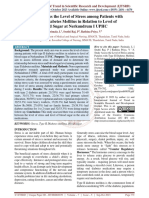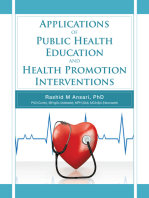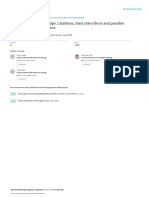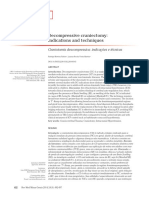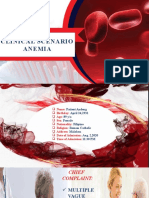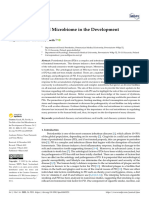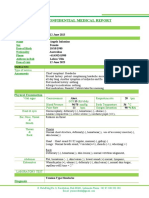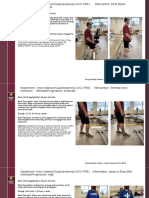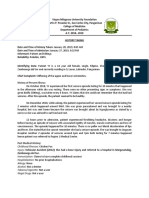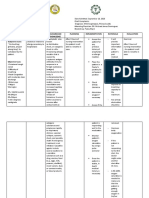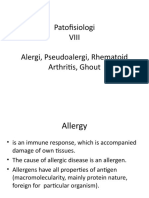Prevalence and Risk Factors of Psychiatric Symptoms Among Type 2 Diabetes Mellitus Patients in South India: A Cross-Sectional Study.
Prevalence and Risk Factors of Psychiatric Symptoms Among Type 2 Diabetes Mellitus Patients in South India: A Cross-Sectional Study.
Volume 9, Issue 8, August – 2024 International Journal of Innovative Science and Research Technology
ISSN No:-2456-2165 https://doi.org/10.38124/ijisrt/IJISRT24AUG927
Prevalence and Risk Factors of Psychiatric Symptoms
among Type 2 Diabetes Mellitus Patients in South
India: A Cross-Sectional Study.
Suguna Utchimahali1; S. Kannan2 Kumaravel Velayutham3
Ph.D. Research Scholar1; MD., MSc. Diab(Lond), DNB(Endo), MNAMS,
Ph.D. Professor, Head & Chairperson 2 Director & Consultant Endocrinologist,
Department of Environmental Studies, School of Energy, Alpha Hospital & Research Centre Institute
Environment and Natural Resources, Madurai Kamaraj of Diabetes and Endocrinology,
University, TN, India. TN, India.
Abstract:- Keywords:- Type 2 Diabetes Mellitus, Uncontrolled
Diabetes, Depression, Anxiety, Stress, Statistical Analysis.
Background:
Type 2 diabetes mellitus poses a momentous I. INTRODUCTION
challenge when accompanied by psychiatric symptoms
like depression, anxiety, and stress, adding to the Diabetes mellitus (DM) is a severe and chronic inherited
complaint's threat. Research on these factors in patients metabolic disorder affecting 530 million people globally,
with uncontrolled chronic illnesses in India, particularly with a significant prevalence of three in every four adults
in Tamil Nadu, is limited. Hence, this study aims to living in low and middle-income countries.[1] In 2019,
determine the prevalence and risk factors of these diabetes caused 4.2 million deaths and accounted for at least
psychiatric symptoms among Type 2 diabetes patients. 10% of the global health expenditure, amounting to USD 760
billion.[2] According to the World Health Organization
Methods: (WHO) 2022, India ranks second globally, with 74.9 million
A cross-sectional study was conducted in Alpha adults (aged 20-79) living with diabetes, and this number is
Hospital and Research Center in Madurai, South India, expected to rise to 124.8 million by 2045.[3] In Tamil Nadu,
from April 2020 to March 2021, enrolling 614 participants the prevalence of diabetes is notable, accounting for 21.9%,
(307 with Type 2 diabetes mellitus and 307 general 20.3%, and 13.4% in cities, towns, and peri-urban villages,
population). Data were collected using Hamilton respectively.[4]
Depression Rating Scale, Hamilton Anxiety Rating Scale
and Perceived Stress Scale. The IBM SPSS version 23 was Type 2 diabetes mellitus (T2DM) is the most common
used for statistical analysis. form of diabetes in India. It is characterized by chronic
hyperglycemia resulting from insulin resistance or
Results: insufficient insulin production.[5] Persistent hyperglycemia
Two-thirds of youth women with type 2 diabetes in uncontrolled diabetes mellitus can cause several
have higher fasting blood sugar levels than men when complications such as cardiovascular disease, hypertension,
compared to general population. 82.61% of patients with chronic kidney disorder, neuropathy, nephropathy, and
uncontrolled diabetes developed severe stress, surpassing retinopathy.[6] People with T2DM have higher risks of
those with well-controlled and pre-diabetes. Severe morbidity, mortality, [7] and increased healthcare costs
depression is most prevalent among patients with compared to the general population.[2]
neuropathic foot ulcers (54.76%) and nephropathy
(61.54%). Predominant mental health risk factors include Comorbid psychiatric symptoms like depression,
being single, high school education, poor glycemic control, anxiety, and stress (DAS) can make managing type 2 diabetes
comorbid hypertension, and family history. Interestingly, (T2DM) extremely difficult. These symptoms are the most
lifestyle factors like alcohol use and smoking positively common mental illnesses in current times, and they can either
impact mental health outcomes. contribute to the progression of the disease or increase the risk
of developing diabetes [8]. Prolonged exposure to this
Conclusion: circumstance makes it an integral part of the patient's life.
This study shows the intricate connection between These symptoms have several detrimental effects on the
Type 2 diabetes and mental health problems in Madurai, patient's health, including medication non-adherence, rapid
emphasizing the necessity for a multidisciplinary strategy disease progression, and a generally poor prognosis.[9]
to enhance outcomes and reduce financial burden. Future
research in nursing has to focus on implementing and
assessing therapies aimed at reducing patients' stress,
anxiety and depression.
IJISRT24AUG927 www.ijisrt.com 1410
Volume 9, Issue 8, August – 2024 International Journal of Innovative Science and Research Technology
ISSN No:-2456-2165 https://doi.org/10.38124/ijisrt/IJISRT24AUG927
The World Health Organization highlights the two-way II. MATERIALS AND METHODS
relationship between physical and mental health. However, in
India, the focus on treating diabetes often prioritizes the A. Research Design
physical complications of type 2 diabetes (T2DM), with little A cross-sectional study was carried out from December
attention to the mental well-being of these patients. Factors 19, 2020, to December 30, 2021, with 614 participants,
contributing to DAS vary across study populations and have consisting of 307 patients with T2DM and 307 individuals
not been adequately studied together using standard from the general population. The process that was followed
psychological tools in the population of South India, for the study is shown in Fig. 1. Using the probability
particularly in Tamil Nadu. [10,11] Additionally, there is a selection method, the participants were chosen from the
lack of studies investigating the prevalence of DAS in diabetic and endocrinology-focused Alpha Hospital and
individuals with T2DM compared to the general population. Research Centre in Madurai, Tamil Nadu, India. People had
The current study aims to analyze the prevalence and risk to be willing to participate in order to meet the inclusion
factors associated with these conditions at a tertiary care requirements, and the study was not open to anyone with a
center in the Madurai district of Tamil Nadu. history of serious illness or mental health disorders. As a
comparison group, a general population group with
comparable sociodemographic and clinical characteristics
(FBS levels) was gathered. The majority of the people in this
category were the patients' healthy relatives.
Fig 1: Selection Process Followed for the Studied Participants
B. Data Collection alcohol consumption, and difficulty sleeping were also
investigated. Diabetes diagnosis followed the American
Assessment of Socio-Demographic and Clinical Profile: Diabetes Association's guidelines, with patients considered
The study used a structured form to gather diabetic if they had HbA1c levels of 6.5% or higher [6], or
sociodemographic information from all participants through fasting plasma glucose levels of 126 mg/dL or higher in two
interviews. This included age, gender, marital status, separate tests.[13]
educational qualification, occupational status, monthly
income, and socioeconomic status based on Kuppuswamy's Assessment of Depression, Anxiety and Stress:
modified Socioeconomic Status scales.[12] Biochemical test The assessment of Depression, Anxiety, and Stress
reports were obtained from the hospital database on the same utilized three scales, the Hamilton Depression Rating Scale
day of the patient’s visit. In addition to this, the researcher (HAM-D), Hamilton Anxiety Rating Scale (HAM-A), and
collected the clinical profiles of T2DM participants through the Perceived Stress Scale (PSS).
the interview method. Lifestyle habits related to smoking,
IJISRT24AUG927 www.ijisrt.com 1411
Volume 9, Issue 8, August – 2024 International Journal of Innovative Science and Research Technology
ISSN No:-2456-2165 https://doi.org/10.38124/ijisrt/IJISRT24AUG927
HAM-D was employed to gauge the presence and D. Ethical Approval and Informed Consent Statements
severity of depression over the past week. This scale is widely This study was approved by the Internal Research and
acknowledged as the gold standard for assessing depression Review Board (IRB), Ethical Clearance (EC), Biosafety and
and has been extensively used in India. On the 17-item HAM- Animal Welfare Committee of Madurai Kamaraj University,
D scale, the scores between 0 and 7 suggest normalcy, 8-13 Madurai (Registration ID: EC/MKU/20-21/039) on 11th
indicate mild depression, 14-18 indicate moderate December 2020. All participants provided written informed
depression, and a score of 19 - 54 indicates severe depression. consent prior to enrolment in the study. This research was
A study by Dedeken., et al. found that Cronbach’s alpha for conducted ethically in accordance with the World Medical
the HAM-D 17 items was 0.92, indicating a high level of Association Declaration of Helsinki.
internal consistency.[14]
E. Statistical Analysis
The HAM-A is a tool used to measure anxiety The data was entered into Microsoft Excel, and IBM
symptoms through 14 different items. Scores on the scale SPSS Version 23.0.1.0 was used for data analysis. A
range from 0 to 56, with a score of less than 17 indicating descriptive statistical analysis was conducted for continuous
mild severity, 18-24 indicating mild to moderate severity, and and categorical variables. The normalcy was evaluated using
25-30 indicating moderate to severe conditions. The scale has the Shapiro-Wilk test. Non-parametric tests such as the
a high level of internal consistency, indicated by Cronbach's Kruskal-Wallis H test, Mann-Whitney U test, and Chi-square
alpha of 0.893.[15] test were used because it was discovered that the data was not
normally distributed. Binary logistic regression models were
Perceived Stress Scale (PSS) is used to assess perceived applied to examine associations between predictor variables
stress levels. This scale used a five-point Likert scale ranging and the risk of DAS. In the Multivariate logistic regression
from 0 (never) to 4 (very often) to gauge responses to model, severe depression and very severe depression cases
questions such as "In the last month, how often have you felt were grouped into a "severe depression" category, leaving the
upset?" Increases in perceived stress were correlated with other severity levels unaffected. Odds ratios (OR) with 95%
higher scores on the measure. The scale showed good internal confidence intervals were calculated to determine
consistency with a Cronbach's alpha of 0.85.[16] independent associations between T2DM and
depression/anxiety disorders. The P value of 0.05 was used
C. Sample Size Determination as the standard for statistical significance.
In an initial pilot study, 40 participants with T2DM were
(excluded from the main study) to determine the sample size. III. RESULTS
The prevalence of DAS symptoms among 11 out of the 40
T2DM patients was found to be 27.5%. Following the Central A cross-sectional study in Madurai, Tamil Nadu,
Limit Theorem by Hans Fischer [17], the sample size (n) was examined the prevalence of DAS and its risk factors among
calculated using the formula: N = (Z^2 x p x (1-p))/d^2. In T2DM patients. Out of 614 participants, 307 had T2DM, and
this formula, 'N' represents the desired sample size, 'Z' is the 307 were from the general population. The study highlighted
standard normal deviation at a 95% confidence interval the demographic, socioeconomic, mental health, and clinical
(1.96), 'p' is the prevalence value of DAS symptoms among factors affecting FBS levels in T2DM patients, unlike the
T2DM (0.275), and (1−p) represents the margin of error (5%). stable levels in general individuals.
The minimum sample size calculated was 306.24, rounded up
to 307 using this formula.
Table 1: Characteristics of T2DM Patients and Healthy Individuals and their Association with Fasting Blood Sugar Levels
Descriptive statistics Healthy Group (n=307)
T2DM patients (n=307) Fasting Blood Sugar Levels
Fasting Blood Sugar Levels
Variables Category N (%) Median U/H N (%) Median U/H
(Q1, Q3) score (Q1, Q3) Score
Socio-demographic Profile
Age (years) 18-23 39 (12.7) 139.21 2.900 19 (6.18) 98.3 2.394
(125.31,218.92) (89.5,99)
24-40 134 (43.6) 162.56 22 (7.16) 98.3
(127.7,238.58) (89.5,99)
41-60 113 (36.8) 145.7 132 (43) 98.3
(127.86,229.12) (97.3,99.11)
61 and 21 (6.8) 157.3 114 (37) 98.2
above (127.88,218.92) (97,98.8)
Gender Male 107 (34.9) 144 10059.5 113 (36.8) 98.3 10447.5
(127.33,235) (97,99)
Female 200 (65.1) 157.2 194 (63. 1) 98.2
(127.33,235) (97.2,99)
Marital Unmarried 54 (17.6) 159.87 1.735 55 (17.9) 98.3 0.630
IJISRT24AUG927 www.ijisrt.com 1412
Volume 9, Issue 8, August – 2024 International Journal of Innovative Science and Research Technology
ISSN No:-2456-2165 https://doi.org/10.38124/ijisrt/IJISRT24AUG927
Status (126.48,238) (97,99)
Married 223 (72.6) 157.51 214 (69.7) 98.3
(127.91,235.61) (97.4,98.9)
Others 30 (9.8) 136 38 (12.3) 98
(126.64, (96.9,99)
218.21)
c
Educational No formal 87 (28.3) 188.13 5.510 77 (25) 98.11 1.713
Qualification Education (128.31,245.32) (95.52, 99)
to middle
school
High School 82 (26.7) 143.11 85 (27.6) 98.11
(126.4,181.55) (97.3,99)
Diploma 138 (45) 161 145 (47.2) 98.3
and above (126.94,238.58) (97.3,99)
Occupation Unemployed 193 (62.9) 143.33 1.181 75 (24.4) 98.3 0.024
(127.8,221.53) (96.9,99)
Daily Wage 48 (15.6) 147.87 114 (37) 98.2
and (127.58,223.5) (97,99)
Business
Others 66 (21.5) 160.27 118 (38.4) 98
(126.61,247.42) (97.6-99)
b
Income Housewife 135 (44) 160.27 7.295 125 (40.7) 98.3 0.770
(in Rupees) /Student (126.61,247.4) (97.3,99)
less than 72 (23.5) 157,42 141 (45.9) 98.2
18496 (126.52,237.16) (97.99)
18497 above 100 (32.6) 144.41 41 (13.3) 98.3
(128.17,221.88) (95.4, 99.3)
Economic Upper class 34 (11.1) 128.32 (118.13- 1.529 22 (7.16) 98.2 0.331
status 219) (95.6,98.8)
Middle class 78 (25.4) 160.20 141 (45.9) 98.3
(128.11,237.11) (97,99)
Lower class 195 (63.5) 147.92 144 (46.9) 98.3
(126.8,230.13) (97.3, 99)
Mental Health Risk Factors
Depression Mild 72 (23.45) 188 2.069 256 (83.3) 98.26 0.838
(127,255) (97,99)
Moderate 74 (24.1) 146 49 (15.9) 98.3
(125.8,237.9) (97.5,99)
Severe 160 (52.11) 145 2 (0.65) 95.5
(128,225.6) (92.7,99)
Anxiety Mild 35 (11.4) 231 3.211 202 (65.7) 98.3 1.729
(128,276) (97.3,99)
Moderate 39 (12.7) 158.4 96 (31.2) 98.26
(123.6, 235.6) (96.9,99)
Severe 233 (75.89) 147.9 9 (2.93) 98
(127.5,225) (94.5,98.5)
Stress Mild 16 (5.21) 128.98 3.275 147 (47.8) 98.2 1.065
(123.4,217) (97,99)
Moderate 152 (49.51) 160 156 (50.8) 98.3
(128,235.9) (97.3,99)
Severe 139 (45.27) 144.6 4 (1.3) 97.8
(127,225.8) (91.7,98)
Clinical Profile
Body Mass Normal 165 (53.74) 147 535.5
Index (BMI) (126.4,235)
Overweight 120 (39) 159.4
(127.9, 235)
Obese 22 (7.16) 150.6
(128,231.6)
Adherence to Yes 156 (50.8) 146.4 11559
IJISRT24AUG927 www.ijisrt.com 1413
Volume 9, Issue 8, August – 2024 International Journal of Innovative Science and Research Technology
ISSN No:-2456-2165 https://doi.org/10.38124/ijisrt/IJISRT24AUG927
Healthy (128,228.9)
Diet (ADH) No 151 (49.2) 160
(126.5,237)
Medical T2DM 244 (79.5) 152.8 7515.5
Condition (127.9, 230.8)
T2DM + 63 (20.5) 156.7
HTN (125,237)
Adherence to Yes 60 (19.5) 143.9 6878
Physical (128,220.6)
Activity No 247 (80.5) 157.5
(APA) (127.2,236)
Family Present 120 (39.1) 136.4 9820
History (126, 227.5)
Absent 187 (60.9) 160
(128, 235.61)
Menstrual Present 15 (7.5) 188.2 347.24
Irregularities (126,243)
(n=200) Absent 185 (92.5) 152.3
(127.5,233)
a
Smoking Present 4 (1.3) 259 203.50
(228.8,296)
Absent 303 (98.69) 148.5
(127,233.5)
Alcohol use Present 46 (15) 177.9 5655.5
(126.8,236)
Absent 261 (85) 147.9
(127,231.47)
a
Insomnia Present 68 (22.1) 190.5 6523
(128.7,261)
Absent 239 (77.9) 145.7
(126.8,225)
On OHD 212 (69.06) 157 12.362
Medication (127.5,233)
IT 59 (19.21) 145.7
(126.5,255)
Both 36 (11.73) 148.2
(128.2,224.8)
Complication Present 177 (57.65) 165.57 445.429
(128.27-
245.41)
Absent 130 (42.34) 144
(126.77-
223.33)
Note: aP < 0.05, bP < 0.01, cP < 0.001 ( P = Significant Value)
Table 1 displays the sociodemographic profile, mental higher in T2DM patients compared to the general population
health well-being status, and comparison of FBS scores i.e. depression (23%, 24%, 52% vs. 83.3%, 16%, 0.65%),
between T2DM patients and the general population based on anxiety (11%, 13%, 78% vs. 65.7%, 31.2%, 2.93%), and
the descriptive analysis and Mann-Whitney U test stress (5%, 50%, 45% vs. 47.8%, 50.8%, 1.3%). In T2DM
respectively. The median FBS levels of T2DM patients aged patients, mild depression [188 (Q1: 127, Q3: 255)] and mild
24 to 40 years (44%) [162.56 (Q1: 127.7, Q3: 238.58)] and anxiety [231 (Q1: 128, Q3: 276)] are linked to increased FBS
females (65%) [157.2 (Q1: 127.33, Q3: 235)] are higher than levels, while FBS levels in healthy individuals remain consistent
those of their counterparts. General population without DM across mental health categories. Among T2DM patients, only 4
have constant median FBS levels across age groups and smoked, and 22.10% suffered from insomnia, both showing high
genders. In T2DM patients, FBS levels were statistically FBS levels [259 (Q1: 228.8, Q3: 296), p < 0.05] and [190.5 (Q1:
128.7, Q3: 261), p < 0.05], respectively. Other clinical factors
significant among the lowest income category, including associated with high median FBS levels included BMI (overweight
housewives and students (n=135) [160.27 (Q1: 126.61, Q3: 39%), diabetic complications (57.65%), oral hypoglycemic
247.4), p = 0.01], and those with no formal education up to medications (69.06%) and alcohol use (15%). Notably, 60.9%
middle school (n=28) [188.13 (Q1: 128.31, Q3: 245.32), p = of T2DM patients without a family history of diabetes
0.001]. The mild, moderate and severe levels of DAS were showed higher FBS levels [160 (Q1: 128, Q3: 235.61)].
IJISRT24AUG927 www.ijisrt.com 1414
Volume 9, Issue 8, August – 2024 International Journal of Innovative Science and Research Technology
ISSN No:-2456-2165 https://doi.org/10.38124/ijisrt/IJISRT24AUG927
Fig 2: Impact of DAS on the Diabetes Status among the T2DM Patients
Fig. 2 demonstrates the impact of DAS on the diabetes In Table 2, the fully adjusted logistic regression analysis
status among patients with Type 2 Diabetes Mellitus (Model 2), perceived stress was found to be significantly
(T2DM). It indicates that in patients with controlled type 2 associated with participants' Married status (AOR: 0.000, p =
diabetes, severe depression (54.76%), severe anxiety 0.02), FBS levels (AOR: 2943.3, p = 0.009), comorbid
(50.00%), and severe stress (80.95%) are highly prevalent; in conditions of T2DM and hypertension (AOR: 0.000, p =
pre-diabetes patients, there is significant difference in 0.04), APA (AOR: 0.000, p = 0.03), and family history (AOR:
moderate (52.38%) and severe (39.68%) depression, severe 17261.6, p = 0.03). Similarly, anxiety scores showed
anxiety (61.90%), and severe stress (79.37%); in patients with significant associations with participants' high school
uncontrolled type 2 diabetes, there is a higher likelihood of educational qualification (AOR: 6.185, p = 0.02), mode of
moderate (52.17%) and severe (47.83%) depression, severe treatment – “Both” with OHD and Insulin therapy (AOR:
anxiety (65.22%), and severe stress (82.61%). 0.209, p = 0.01) and smoking (AOR: 0.036, p = 0.03).
Furthermore, depression scores were found to be significantly
associated with participants' single status (AOR: 5.540, p =
0.03), high school educational qualification (AOR: 3.312, p =
0.01), and alcohol use (AOR: 0.382, p = 0.02).
Table 2: Mental Health Risk Associated with T2DM Patients
Stress Anxiety Depression
a c d
Personal COR Model Model 2 COR Model Model 2 COR Model Model 2
Background [95% 1 [95% CI] 1 [95% 1
e b
CI] AOR AOR AOR AOR CI] AOR AOR
[95% [95% CI] [95% [95% CI] [95% [95%
CI] CI] CI] CI]
Socio-Demographic Profile
Age 2.949 146.6 1.903 1.211 1.111 0.575
18-23 years f® [0.752- [0.004- [0.746- [0.262- [0.501- [0.171-
24-40 years 11.52] 587] 4.854] 5.599] 2.465] 1.932]
41-60 years 1.731 0.037 3.908 2.662 1.721 0.850
[0.478- [0.000- [1.313- [0.457- [0.741- [0.230-
6.265] 155.5] 11.628] 15.502] 4.00] 3.132]
61 years and 0.000 0.000 1.097 0.836 0.982 0.525
above [0.288- [0.101- [0.303- [0.104-
4.181] 6.940] 3.183] 2.652]
Gender Male® 0.886 5.097 1.283 2.341 0.756 1.707
Female [0.313- [0.001- [0.624- [0.426- [0.429- [0.459-
2.508] 34007.1] 2.639] 12.853] 1.332] 6.342]
m l m
Marital Status 0.218 0.000 0.345 0.404 0.778 0.969
Unmarried® [0.073- [0.000- [0.161- [0.124- [0.402- [0.383-
IJISRT24AUG927 www.ijisrt.com 1415
Volume 9, Issue 8, August – 2024 International Journal of Innovative Science and Research Technology
ISSN No:-2456-2165 https://doi.org/10.38124/ijisrt/IJISRT24AUG927
0.650] 0.276] 0.741] 1.324] 1.502] 2.453]
Married
k l
Others 0.454 0.47 0.000 0.000 4.583 5.540
[0.090- [0.13, [1.058- [1.097-
2.293] 1.64] 19.864] 27.990]
l k m l
Education 1.975 14155.0 4.626 6.185 2.903 3.312
Qualification [0.571- [0.640- [1.267- [1.310- [1.294- [1.252-
No formal 6.826] 313042.2] 16.887] 29.210] 6.514] 8.765]
Education
to middle school
®
High School
Diploma and 3.392 51.130 1.100 1.305 1.061 0.883
above [ 0.990- [0.496- [0.513- [0.412- [0.585- [0.389-
11.630] 526.8] 2.359] 4.133] 1.926] 2.0]
l
Occupation 1.297 0.052 1.900 6.185 2.56 2.739
Unemployed® [0.240- [0.000- [0.647- [1.310- [1.062- [0.677-
Daily Wage and 6.998] 1617.6] 5.577] 21.210] 6.179] 11.080]
Business
Others 1.017 0.009 1.632 1.305 1.171 1.491
[0.210- [0.000- [0.597- [0.412- [0.530- [0.298-
4.926] 1001.7] 4.466] 4.133] 2.587] 7.468]
Economic status 0.000 1.326 1.979 1.172 1.087 0.397
Upper class® [0.000] [0.204- [0.068- [0.115- [0.029-
Middle class 19.197] 20.294] 10.261] 5.484]
Lower class 0.000 0.005 1.966 2.010 0.688 0.233
[0.000] [0.210- [0.093- [0.075- [0.014-
18.388] 43.460] 6.293] 3.801]
Clinical Parameters
Duration of 2.196 3.589 0.718 1.221 1.330 1.499 0.814 0.837 0.732
Treatment [0.692- [0.684- [0.002- [0.590- [0.593- [0.545- [0.479- [0.466- [0.363-
6.973] 18.817] 259.146] 2.525] 2.983] 4.124] 1.382] 1.504] 1.478]
HbA1c 1.259 0.789 18.378 1.298 1.023 0.559 1.035 1.015 0.740
[0.395- [0.155- [0.072- [0.616- [0.433- [0.194- [0.580- [0.534- [0.356-
4.012] 4.011] 4683.9] 2.736] 2.415] 1.608] 1.848] 1.931] 1.540]
l l l
FBS 3.414 9.73 2943.3 1.224 1.175 1.520 1.179 1.484 1.723
[1.217- [1.975- [7.075- [0.526- [0.418- [0.461- [0.620- [0.686- [0.749-
9.571] 48.414] 122455.9] 2.848] 3.301] 5.008] 2.242] 3.209] 3.964]
SBP 2.695 1.821 59.321 1.166 1.145 0.936 1.119 1.109 0.634
[0.891- [0.404- [0.389- [0.455- [0.400- [0.272- [0.547- [0.499- [0.254-
8.149] 8.211] 9056.1] 2.983] 3.273] 3.216] 2.288] 2.465] 1.580]
m l k
Medical 0.233 0.167 0.000 0.855 0.792 0.835 0.728 0.695 0.523
Condition T2DM [0.084- [0.043- [0.000- [0.368- [0.310- [0.280- [0.390- [0.352- [0.240-
® 0.648] 0.647] 0.739] 1.987] 2.025] 2.484] 1.357] 1.375] 1.138]
T2DM + HTN
T2DM 0.604 0.330 0.264 0.783 0.849 0.877 0.935 0.983 0.766
Complications [0.205- [0.080- [0.004- [0.379- [0.391- [0.351- [0.548- [0.553- [0.396-
Absent® 1.782] 1.363] 16.279] 1.619] 1.844] 2.194] 1.594] 1.747] 1.479]
Present
Medicationmode 1.560 2.298 5478.9 0.547 0.598 0.800 0.600 0.538 0.514
OHD® [0.336- [0.379- [0.059- [0.233- [0.238- [0.266- [0.318- [0.269- [0.234-
Insulin Therapy 7.240] 13.940] 50678.0] 1.282] 1.499] 2.403] 1.132] 1.076] 1.128]
l l
Both 0.602 0.544 0.001 0.408 0.391 0.209 1.180 1.222 1.173
[0.159- [0.067- [0.000- [0.158- [0.141- [0.059- [0.486- [0.469- [0.400-
2.273] 4.432] 7.792] 1.055] 1.083] 0.745] 2.864] 3.185] 3.441]
BMI Normal ® 0.823 0.566 4.392 0.857 1.024 1.151 0.889 0.928 0.811
Overweight [0.290- [0.136- [0.039- [0.413- [0.466- [0.459- [0.516- [0.517- [0.427-
2.334] 2.353] 497.4] 1.778] 2.252] 2.887] 1.531] 1.665] 1.543]
Obese 1.070 1.844 0.022 1.224 1.416 1.067 1.960 2.190 2.444
[0.127- [0.108- [0.000- [0.264- [0.253- [0.163- [0.551- [0.576- [0.569-
IJISRT24AUG927 www.ijisrt.com 1416
Volume 9, Issue 8, August – 2024 International Journal of Innovative Science and Research Technology
ISSN No:-2456-2165 https://doi.org/10.38124/ijisrt/IJISRT24AUG927
8.988] 31.423] 55.121] 5.676] 7.923] 6.978] 6.977] 8.334] 0.495]
i k k
APA No ® 0.513 0.176 0.000 0.798 0.652 0.359 1.031 0.747 0.558
Yes [0.171- [0.029- [0.000- [0.343- [0.245- [0.111- [0.530- [0.347- [0.233-
1.536] 1.068] 0.579] 1.857] 7.923] 1.165] 2.007] 1.610] 1.339]
j k
AHD No® 1.035 3.184 281.7 0.855 1.031 1.032 1.672 1.795 1.815
Yes [0.378- [0.617- [0.702- [0.422- [0.453- [0.404- [0.982- [0.967- [0.906-
2.832] 16.428] 113114.2] 1.732] 2.347] 2.632] 2.848] 3.335] 3.636]
k k
Family History 2.914 4.918 17261.6 0.645 0.728 0.526 1.420 1.762 1.680
Absent® [0.813- [0.948- [1.797- [0.318- [0.333- [0.205- [0.817- [0.952- [0.835-
Present 10.44] 25.5] 165804.7] 1.308] 1.589] 1.353] 2.470] 3.256] 3.381]
k k
Smoking 0.000 0.058 0.000 0.1221 0.121 0.036 0.935 0.708 0.619
Absent ® [0.017- [0.11- [ 0.002- [0.096- [0.056- [0.041-
Present 0.897] 1.291] 0.808] 9.129] 8.912] 9.414]
k l k
Alcohol use 2.744 11.614 511293.5 0.548 0.628 0.774 0.466 0.404 0.382
Absent ® [0.354- [0.500- [0.232- [0.243- [0.251- [0.239- [0.194- [0.168-
Present 21.294] 269.9] 1.295] 1.627] 2.384] 0.909] 0.841] 0.867]
l k
Insomnia 0.341 0.211 0.051 0.578 0.641 0.660 0.684 0.700 0.879
Absent ® [0.122- [0.055- [0.002- [0.268- [0.279- [0.243- [0.374- [0.367- [0.426-
Present 0.953] 0.804] 1.164] 1.251] 1.474] 1.792] 1.252] 1.335] 1.814]
Note : a Crude Odds ratio, bAdjusted Odds ratio, c Partially adjusted regression model, d Fully adjusted regression model,
e
CI: Confidence Interval, f Reference, I Adherence to Physical Activity , j Adherence to Healthy Diet, Significant Value (P)
k
P < 0.05, l P < 0.01, m P< 0.001,
Fig. 3 projects the prevalence of severe depression, foot ulcers (50%), hypertension (61.90%), and retinopathy
anxiety, and stress in patients suffering from different T2DM (65.22%); and severe stress is alarmingly prevalent in all
complications. Across all complication categories, severe categories, especially among patients with neuropathic foot
depression is most prevalent among patients with neuropathic ulcers (80.95%), hypertension (79.37%), and retinopathy
foot ulcers (54.76%) and nephropathy (61.54%); severe (82.61%).
anxiety is particularly common in patients with neuropathic
Fig 3: Impact of DAS on T2DM Complications among T2DM Patients
IV. DISCUSSION et al. (2012), which reported higher FBS levels in older
working-age groups. Female patients had a higher median
A. Prediction of FBS Levels Status among T2DM Patients FBS (157.2 mg/dL) than males, but healthy individuals
and the General Participants maintained consistent FBS levels across all ages and genders.
The study examined the prevalence of fasting Lower education levels and lower income groups (such as
hyperglycemia in young adults (aged 24–40) with T2DM, housewives and students) were linked to higher FBS levels in
finding an average FBS level of 162.56 mg/dL, which is T2DM patients, in line with studies in Taiwan and Korea.
higher than in other age groups. This finding contrasts with [18,19]
previous studies by Chandrupatla., et al (2021) and Rajput.,
IJISRT24AUG927 www.ijisrt.com 1417
Volume 9, Issue 8, August – 2024 International Journal of Innovative Science and Research Technology
ISSN No:-2456-2165 https://doi.org/10.38124/ijisrt/IJISRT24AUG927
Among clinical parameters, complications (165.57 studied population.[33] Patients with a family history have
mg/dL) and use of oral hypoglycemic medications (157 higher likelihood of experiencing stress. Managing diabetes in
mg/dL) were linked to higher FBS levels in type 2 diabetes individuals with a family history requires constant monitoring
patients, while healthy individuals showed stable FBS levels. and lifestyle adjustments, leading to ongoing stress.[34]
These findings are consistent with earlier studies conducted Regular physical activity and adherence to a healthy diet,
by Bin Rakhis., et al. (2022) and Lorenzati., et al. (2010). generally have protective effects against mental health
Lifestyle factors, such as smoking and insomnia, were issues.[35] Lifestyle risk factors like alcohol use and smoking
significantly associated with the highest median FBS levels, have a complex relationship. They may initially reduce
similar to a 2015 study done by Bhaskar et al. linking depression and anxiety due to self-medication effects, but
insomnia to a 33% higher risk in adult T2DM patients. long-term use is generally harmful. [36]
Interestingly, individuals without a family history of diabetes
had higher FBS levels (160 mg/dL) compared to those with a D. Impact of DAS on the T2DM Complications among the
family history (136.4 mg/dL), possibly due to better lifestyle T2DM patients
adjustments among those aware of their genetic risk.[20] The study shows a high incidence of stress, anxiety, and
depression among patients with diabetic complications. This
B. Prevalence of DAS among T2DM Patients highlights the significant mental health burden associated
The prevalence of severe DAS in our sample is notably with the condition. Previous research conducted by Tapp, R.
higher than in previous studies among T2DM patients in J., et al. (2006) and Ali Ahmad., et al. (2014), also supports
Qatar (13.6%, 35.3%, and 23.4%) [21], Bahrain (11.9%, this outcome.
41.3%, and 21%) [22] and Kathmandu, Nepal (10.8% and
4.7%)[2]. In North India, the rates were 26.3%, 27.6%, and E. Limitation and Strength of the Study
21%, respectively.[23] In South India, specifically Tamil The research was limited to one healthcare institute, so
Nadu, the prevalence of depression was 15.1% in Chennai the results may not apply to larger groups of people.
[24], 6.3% for depression and 10.4% for anxiety in Madurai Furthermore, most participants had serious health issues, such
district[9] and high perceived stress in both genders in as severe complications of T2DM, which could have affected
Perambalur district.[25] Limited data, especially with all the observed DAS. Despite its limitations, the study is notable
three DAS disorders from Tamil Nadu contrasts with a study for its thorough methodology and valuable insights into the
by Alzahrani., et al (2019) in Saudi Arabia, showing mild, T2DM-DAS connection. It effectively compares health
moderate, severe, and extremely severe depression in 9.3%, outcomes between T2DM patients and the general population
14.0%, 7.1%, and 3.3% of T2DM patients, respectively. The and includes diverse samples from a tertiary care hospital for
possible reason for the high prevalence of DAS among T2DM accuracy. In the future, it is imperative for diabetes research
patients in this study could be due to a combination of cultural to incorporate samples from different geographical locations
stigma and limited awareness about mental health, and conduct a meta-analysis to definitively determine the
socioeconomic challenges, inadequate access to quality prevalence of DAS in individuals with type 2 diabetes. Future
healthcare and the complexity of diabetes management. [26] research in nursing have to focus on implementing and
assessing therapies aimed at reducing patients' stress, anxiety,
C. Mental Health Risk Factors Associated with T2DM and depression.
Patients
This groundbreaking research is the first to investigate V. CONCLUSION
the risk factors associated of depression, anxiety, and stress
among T2DM patients, using standard tools HAM-D, HAM- T2DM and mental health disorders often coexist due to
A and PSS available in the public domain. The study found biological, psychological, and social factors. This study
that being married is linked to lower stress, highlighting the examined how socio-demographic, mental health (DAS), and
mental health benefits of social support. [27] Conversely, clinical factors relate to T2DM, comparing these aspects with
single status individuals are five times more likely to the general population to evaluate the prevalence of DAS risk
experience depression due to a lack of social support.[28] among T2DM patients in Madurai. The study highlights that
Patients with only a high school education are six times more two-thirds of young women with type 2 diabetes have higher
likely to develop anxiety and three times more likely to suffer FBS levels than men when compared to the general
from depression, suggesting that limited health literacy makes population. There is a notably high prevalence of severe
diabetes management more challenging.[29,30] Patients with depression, anxiety, and stress among patients with Type 2
high FBS levels have very high to develop stress[2] and the diabetes mellitus when compared to the general population.
presence of comorbidity with hypertension alongside T2DM 82.61% of the patients with uncontrolled diabetes developed
is significantly associated with stress[31] whereas combined severe stress, more than those with well-controlled and pre-
mode of treatment (Both OHD and Insulin therapy) is diabetes status. Among the T2DM complications, severe
positively associated with anxiety.[7] Lower health literacy depression is most prevalent among patients with neuropathic
has been associated with worse health outcomes and higher foot ulcers (54.76%) and nephropathy (61.54%). Factors such
rates of depression among chronic disease patients.[32] as marital status (single), high school education, poor
Moreover, the study found that the duration of treatment, glycemic control, comorbid conditions of type 2 diabetes with
HbA1c, blood pressure levels, menstrual irregularity, and BMI hypertension and family history are the predominant mental
show no significant association with DAS, indicating that they health risk factors in patients with type 2 diabetes.
might not directly impact these mental health outcomes in the Interestingly, lifestyle factors such as alcohol use and
IJISRT24AUG927 www.ijisrt.com 1418
Volume 9, Issue 8, August – 2024 International Journal of Innovative Science and Research Technology
ISSN No:-2456-2165 https://doi.org/10.38124/ijisrt/IJISRT24AUG927
smoking have a significant positive impact on mental health [6]. Minchala Urgiles, R. E., Tigasi Pastuña, J. A., Estrella
outcomes, possibly due to adaptive coping mechanisms and González, M. A., Ramírez-Coronel, A. A., & Romero
changes in perception. Effective diabetes management is Sacoto, L. A. (2020). Type 2 diabetes mellitus and
crucial in reducing mental health risks. The study underscores chronic complications. International Journal of
the need for comprehensive care in T2DM, emphasizing a Innovative Science and Research Technology, 5(5),
multidisciplinary approach that includes psychological 1906. Available from:
support, lifestyle modifications and effective clinical https://www.ijisrt.com/assets/upload/files/IJISRT20
management to enhance overall well-being and quality of life. MAY828.pdf
[7]. Wambugu, F. K., Nyamai, J. J., & Mogere, D. (2020).
ACKNOWLEDGMENT Knowledge on risk factors of diabetes mellitus 2
among students in selected universities in Rwanda.
We sincerely thank the Department of Environmental International Journal of Innovative Science and
Studies, Madurai Kamaraj University, Madurai (Tamil Nadu) Research Technology, 5(8), 1598. Available from:
India, the members and staff of Alpha Hospital and Research https://www.ijisrt.com/assets/upload/files/IJISRT20A
Center, Institute of Diabetes and Endocrinology, Madurai UG452.pdf
(Tamil Nadu), India and all the participants involved in this [8]. Rahmania, F. A., Rahmayanti, F. D., Hutami, P. T., &
study. Muslaini, R. (2020). Emotional regulation and
psychological well-being in patients with diabetes
REFERENCES mellitus. International Journal of Innovative Science
and Research Technology, 5(8), 1652. Available from:
[1]. International Diabetes Federation. (2021). IDF https://www.ijisrt.com/assets/upload/files/IJISRT20A
Diabetes Atlas (10th ed.). International Diabetes UG676.pdf
Federation. Available from: [9]. Badescu, S. V., Tataru, C., Kobylinska, L., Georgescu,
https://diabetesatlas.org/atlas/tenth-edition/ E. L., Zahiu, D. M., & Zăgrean, A. M., et al. (2016).
[2]. Sharma, K., Dhungana, G., Adhikari, S., Bista Pandey, The association between diabetes mellitus and
A., & Sharma, M. (2021). Depression and anxiety depression. Journal of Medicine and Life, 9(2), 120-
among patients with type II diabetes mellitus in 125. Available from:
Chitwan Medical College Teaching Hospital, Nepal. https://www.ncbi.nlm.nih.gov/pmc/articles/PMC4863
Nursing Research and Practice, 2021, 8846915. 499/
https://doi.org/10.1155/2021/8846915. Available [10]. Mathew, M., Abish, A., Kuriakose, A., Isaiah, J. R.,
from: AMK, & VK. (2013). Predictors of depression among
https://www.hindawi.com/journals/nrp/2021/8846915 patients with diabetes mellitus in Southern India.
/ Asian Journal of Psychiatry, 6(4), 313-317.
[3]. Sun, H., Saeedi, P., Karuranga, S., Pinkepank, M., https://doi.org/10.1016/j.ajp.2013.01.012. Available
Ogurtsova, K., Duncan, B. B., et al. (2022). IDF from:
Diabetes Atlas: Global, regional, and country-level https://www.sciencedirect.com/science/article/abs/pii
diabetes prevalence estimates for 2021 and projections /S1876201813000143
for 2045. Diabetes Research and Clinical Practice, [11]. Swamynathan, M., & Sivasubramanian, P. B. (2020).
183, 109119. Anxiety and depression versus treatment adherence
https://doi.org/10.1016/j.diabres.2021.109119. among type II diabetes mellitus patients at government
Available from: tertiary care institution, Madurai, Tamil Nadu.
https://www.diabetesresearchclinicalpractice.com/arti International Journal of Community Medicine and
cle/S0168-8227(21)00669-9/fulltext Public Health, 7, 2331. Available from:
[4]. Nanditha, A., Snehalatha, C., Satheesh, K., Susairaj, https://www.ijcmph.com/index.php/ijcmph/article/vie
P., Simon, M., Vijaya, L., et al. (2019). Secular trends w/6545
in diabetes in India (STRiDE-I): Change in prevalence [12]. Wani, R. (2019). Socioeconomic status scales-
in 10 years among urban and rural populations in modified Kuppuswamy and Udai Pareekh’s scale
Tamil Nadu. Diabetes Care, 42(3), 476-485. updated for 2019. Journal of Family Medicine and
https://doi.org/10.2337/dc18-1559. Available from: Primary Care, 8(6), 1846.
https://diabetesjournals.org/care/article/42/3/476/358 https://doi.org/10.4103/jfmpc.jfmpc_288_19.
99/Secular-Trends-in-Diabetes-in-India-STRiDE-I Available from:
[5]. Alva, P., Kumari, S., Bhandary, A., Manjeera, L., & https://www.jfmpc.com/article.asp?issn=2249-
Nandan, N. (2023). Association of sex hormone- 4863;year=2019;volume=8;issue=6;spage=1846;epag
binding globulin gene polymorphism and sex e=1849;aulast=Wani
hormone-binding globulin levels in postmenopausal [13]. Young-Hyman, D., De Groot, M., Hill-Briggs, F.,
women in relation to type 2 diabetes mellitus: A case- Gonzalez, J. S., Hood, K., & Peyrot, M. (2022).
control study. Biomedical and Biotechnology Psychosocial care for people with diabetes: A position
Research Journal, 7, 233-237. Available from: statement of the American Diabetes Association.
https://www.bmbtrj.org/article.asp?issn=2588- Diabetes Care, 39, 2126-2140.
9834;year=2023;volume=7;issue=3;spage=233;epage https://doi.org/10.2337/dc16-2053. Available from:
=237;aulast=Alva https://diabetesjournals.org/care/article/39/12/2126/36718/
Psychosocial-Care-for-People-with-Diabetes-A
IJISRT24AUG927 www.ijisrt.com 1419
Volume 9, Issue 8, August – 2024 International Journal of Innovative Science and Research Technology
ISSN No:-2456-2165 https://doi.org/10.38124/ijisrt/IJISRT24AUG927
[14]. Dedeken, P., Nickenig Vissoci, J. R., Sebera, F., Boon, [22]. Almawi, W., Tamim, H., Al-Sayed, N., Arekat, M. R.,
P. A. J. M., Rutembesa, E., & Teuwen, D. E. (2020). Al-Khateeb, G. M., Baqer, A., et al. (2008).
Validity, reliability, and diagnostic cut-off of the Association of comorbid depression, anxiety, and
Kinyarwandan version of the Hamilton Depression stress disorders with type 2 diabetes in Bahrain, a
Rating Scale in Rwanda. Frontiers in Psychology, 11, country with a very high prevalence of type 2 diabetes.
1343. https://doi.org/10.3389/fpsyg.2020.01343. Journal of Endocrinological Investigation, 31(11),
Available from: 1020-1024. https://doi.org/10.1007/BF03345642.
https://www.frontiersin.org/articles/10.3389/fpsyg.20 Available from:
20.01343/full https://link.springer.com/article/10.1007/BF0334564
[15]. Kummer, A., Cardoso, F., & Teixeira, A. L. (2010). 2
Generalized anxiety disorder and the Hamilton [23]. Rajput, R., Yadav, Y., Rajput, M., & Nanda, S. (2012).
Anxiety Rating Scale in Parkinson’s disease. Arquivos Utility of HbA1c for diagnosis of gestational diabetes
de Neuro-Psiquiatria, 68(4), 495-501. Available mellitus. Diabetes Research and Clinical Practice,
from: 98(1), 104-107.
https://www.scielo.br/j/anp/a/VWjZ7z3CnMzhd8JzQ https://doi.org/10.1016/j.diabres.2012.02.018.
LjCRYr/?lang=en Available from:
[16]. Lee, E. H. (2012). Review of the psychometric https://www.diabetesresearchclinicalpractice.com/arti
evidence of the perceived stress scale. Asian Nursing cle/S0168-8227(12)00100-8/fulltext
Research (Korean Society of Nursing Science), 6(4), [24]. Poongothai, S., Pradeepa, R., Ganesan, A., & Mohan,
121-127. Available from: https://www.asian- V. (2009). Prevalence of depression in a large urban
nursingresearch.com/article/S1976-1317(12)00066- South Indian population - The Chennai Urban Rural
4/fulltext Epidemiology Study (CURES-70). PLoS ONE, 4(9).
[17]. Viswesvaran, C., Sanchez, J. I., & Fisher, J. (1999). https://doi.org/10.1371/journal.pone.0007185.
The role of social support in the process of work stress: Available from:
A meta-analysis. Journal of Vocational Behavior, https://journals.plos.org/plosone/article?id=10.1371/j
54(2), 314-334. ournal.pone.0007185
https://doi.org/10.1006/jvbe.1998.1661. Available [25]. Pitchaipillai, V., Thangavel, D., Venkataraman, R.,
from: Muthusamy, A., Rangan, V., & Jayabal, M. (2015).
https://www.sciencedirect.com/science/article/abs/pii Knowledge and practice regarding the role of media in
/S0001879198916615 classroom teaching-learning among the faculty of
[18]. Liao, Y. S., Tsai, W. C., Chiu, L. T., & Kung, P. T. DSMCH, Perambalur, India. International Journal of
(2023). Educational attainment affects the diagnostic Research in Medical Sciences, 3, 3331-3336.
time in type 2 diabetes mellitus and the mortality risk https://doi.org/10.18203/2320-6012.ijrms20151186.
of those enrolled in the diabetes pay-for-performance Available from:
program. Health Policy, 138, 104917. https://www.msjonline.org/index.php/ijrms/article/vi
https://doi.org/10.1016/j.healthpol.2023.104917. ew/1854
Available from: [26]. Dey, S., Mukherjee, A., Pati, M. K., Kar, A.,
https://www.sciencedirect.com/science/article/abs/pii Ramanaik, S., Pujar, A., et al. (2022). Socio-
/S0168851023000149 demographic, behavioural, and clinical factors
[19]. Hwang, J., & Shon, C. (2014). Relationship between influencing control of diabetes and hypertension in
socioeconomic status and type 2 diabetes: Results urban Mysore, South India: A mixed-method study
from Korea National Health and Nutrition conducted in 2018. Archives of Public Health, 80(1),
Examination Survey (KNHANES) 2010–2012. BMJ 108. https://doi.org/10.1186/s13690-022-00996-y.
Open, 4(8), e005710. Available from: Available from:
https://bmjopen.bmj.com/content/4/8/e005710 https://archpublichealth.biomedcentral.com/articles/1
[20]. Al-Goblan, A. S., Al-Alfi, M. A., & Khan, M. Z. 0.1186/s13690-022-00996-y
(2014). Mechanism linking diabetes mellitus and [27]. Vaingankar, J. A., Abdin, E., Chong, S. A., Shafie, S.,
obesity. Diabetes, Metabolic Syndrome and Obesity: Sambasivam, R., Zhang, Y. J., et al. (2020). The
Targets and Therapy, 7, 587-591. Available from: association of mental disorders with perceived social
https://www.ncbi.nlm.nih.gov/pmc/articles/PMC4259 support, and the role of marital status: Results from a
868/ national cross-sectional survey. Archives of Public
[21]. Bener, A. (2011). High prevalence of depression, Health, 78(1), 76. https://doi.org/10.1186/s13690-
anxiety, and stress symptoms among diabetes mellitus 020-00476-1. Available from:
patients. Open Psychiatry Journal, 5(1), 5-12. https://archpublichealth.biomedcentral.com/articles/1
https://doi.org/10.2174/1874354401105010005. 0.1186/s13690-020-00476-1
Available from: [28]. Bulloch, A. G., Williams, J. V., Lavorato, D. H., &
https://openpsychiatryjournal.com/VOLUME/5/PAG Patten, S. B. (2009). The relationship between major
E/5/FULLTEXT/ depression and marital disruption is bidirectional.
Depression and Anxiety, 26(12), 1172-1177.
https://doi.org/10.1002/da.20618. Available from:
https://onlinelibrary.wiley.com/doi/10.1002/da.20618
IJISRT24AUG927 www.ijisrt.com 1420
Volume 9, Issue 8, August – 2024 International Journal of Innovative Science and Research Technology
ISSN No:-2456-2165 https://doi.org/10.38124/ijisrt/IJISRT24AUG927
[29]. Chlapecka, A., Wolfová, K., Frycová, B., &
Čermáková, P. (2023). Educational attainment and
anxiety in middle-aged and older Europeans. Scientific
Reports, 13(1), 15208.
https://doi.org/10.1038/s41598-023-40196-4.
Available from:
https://www.nature.com/articles/s41598-023-40196-4
[30]. Park, S. S., & An, J. Y. (2015). The relevance with
mental health in the activity limitation and the quality
of life in Korean adults. Indian Journal of Science and
Technology, 8(24).
https://doi.org/10.17485/ijst/2015/v8i24/83977.
Available from: https://www.indjst.org/articles/the-
relevance-with-mental-health-in-the-activity-
limitation-and-the-quality-of-life-in-korean-adults
[31]. Tripathi, P., Sharma, B., Kadam, N., Biswas, M., Das,
T., Tiwari, D., et al. (2024). Prevalence and predictors
of anxiety and depression in Indian patients with type
2 diabetes. Annals of Neurosciences.
https://doi.org/10.1177/09727531241244569.
Available from:
https://journals.sagepub.com/doi/full/10.1177/097275
31241244569
[32]. Schillinger, D., Grumbach, K., Piette, J., Wang, F.,
Osmond, D., Daher, C., et al. (2002). Association of
health literacy with diabetes outcomes. JAMA, 288(4),
475-482. https://doi.org/10.1001/jama.288.4.475.
Available from:
https://jamanetwork.com/journals/jama/fullarticle/19
5338
[33]. Raju, M. S. V. K., Singh, H., Bansal, S., Dubey, V.,
Kurrey, R., & Malik, M. (2014). A study of
sociodemographic clinical and glycemic control
factors associated with co-morbid depression in type 2
diabetes mellitus. Industrial Psychiatry Journal,
23(2), 134-140. https://doi.org/10.4103/0972-
6748.151687. Available from:
https://www.industrialpsychiatry.org/article.asp?issn
=0972-
6748;year=2014;volume=23;issue=2;spage=134;epag
e=140;aulast=Raju
[34]. American Psychological Association. (2013). Taking
control of your diabetes. Available from:
https://www.apa.org/news/press/releases/stress/2013/
diabetes-control
[35]. Kang, L., Abascal, L., & Schroeder, J. D. (2024).
Lifestyle mental wellbeing for the primary care visit.
StatPearls Publishing. Available from:
https://www.statpearls.com/ArticleLibrary/viewarticl
e/159547
[36]. Turner, S., Mota, N., Bolton, J., & Sareen, J. (2018).
Self-medication with alcohol or drugs for mood and
anxiety disorders: A narrative review of the
epidemiological literature. Depression and Anxiety,
35(9), 851-860. https://doi.org/10.1002/da.22771.
Available from:
https://onlinelibrary.wiley.com/doi/full/10.1002/da.2
2771
IJISRT24AUG927 www.ijisrt.com 1421
You might also like
- Expanded Program For Immunization CHD Report0% (1)Expanded Program For Immunization CHD Report12 pages
- Assessment of Depression Risk Factors in Type 2 Diabetics at An Outpatient Clinic of A Tertiary Hospital in North Central, NigeriaNo ratings yetAssessment of Depression Risk Factors in Type 2 Diabetics at An Outpatient Clinic of A Tertiary Hospital in North Central, Nigeria11 pages
- Diabetes and Depression: Cross-Sectional Study Among Patients in A Tertiary Healthcare Facility in Accra, GhanaNo ratings yetDiabetes and Depression: Cross-Sectional Study Among Patients in A Tertiary Healthcare Facility in Accra, Ghana28 pages
- A Review of Management and Treatment of Diabetes MellitusNo ratings yetA Review of Management and Treatment of Diabetes Mellitus6 pages
- Risk Assessment of Diabetes Using Diabetes Mellitus Risk Assessment Form Among Population of Kothanavadi Village Chamarajanagra DistrictNo ratings yetRisk Assessment of Diabetes Using Diabetes Mellitus Risk Assessment Form Among Population of Kothanavadi Village Chamarajanagra District4 pages
- Experiences of Adolescents Living with Type 1 Diabetes Mellitus Whilst Negotiating with the SocietyFrom EverandExperiences of Adolescents Living with Type 1 Diabetes Mellitus Whilst Negotiating with the SocietyNo ratings yet
- Diabetes Mellitus and Oral Health: An Interprofessional ApproachFrom EverandDiabetes Mellitus and Oral Health: An Interprofessional ApproachNo ratings yet
- THE BEST TYPE 2 DIABETES KILLER: How to Control Blood Sugar Without DrugsFrom EverandTHE BEST TYPE 2 DIABETES KILLER: How to Control Blood Sugar Without DrugsNo ratings yet
- Machine_Learning_Tools_for_Long-Term_Type_2_Diabetes_Risk_PredictionNo ratings yetMachine_Learning_Tools_for_Long-Term_Type_2_Diabetes_Risk_Prediction21 pages
- A Study Assess The Level of Stress Among Patients With Type II Diabetes Mellitus in Relation To Level of Blood Sugar at Nerkundrum I UPHCNo ratings yetA Study Assess The Level of Stress Among Patients With Type II Diabetes Mellitus in Relation To Level of Blood Sugar at Nerkundrum I UPHC4 pages
- Developing A Modified Logistic Regression Model For Diabetes Mellitus and Identifying The0 Important Factors of Type Ii DMNo ratings yetDeveloping A Modified Logistic Regression Model For Diabetes Mellitus and Identifying The0 Important Factors of Type Ii DM15 pages
- Diabetes Genetic Epidemiology and Associated Comorbidities: A Comprehensive ReviewNo ratings yetDiabetes Genetic Epidemiology and Associated Comorbidities: A Comprehensive Review9 pages
- YOUR DIABETES TOOLKIT: Apps, Resources And Strategies For New PatientsFrom EverandYOUR DIABETES TOOLKIT: Apps, Resources And Strategies For New PatientsNo ratings yet
- A Case Study On The Management of Madhumeha (Type 2 Diabetes Mellitus)No ratings yetA Case Study On The Management of Madhumeha (Type 2 Diabetes Mellitus)3 pages
- Current Treatment Options For Diabetes: A ReviewNo ratings yetCurrent Treatment Options For Diabetes: A Review8 pages
- Advances in Geriatrics: A Comprehensive Guide to Aging, Diseases, and Quality of LifeFrom EverandAdvances in Geriatrics: A Comprehensive Guide to Aging, Diseases, and Quality of LifeNo ratings yet
- Experiences of Adolescents Living with Type 1 Diabetes Mellitus whilst Negotiating with the Society: Submitted as part of the MSc degree in diabetes University of Surrey, Roehampton, 2003From EverandExperiences of Adolescents Living with Type 1 Diabetes Mellitus whilst Negotiating with the Society: Submitted as part of the MSc degree in diabetes University of Surrey, Roehampton, 2003No ratings yet
- The American Diabetes Association/JDRF Type 1 Diabetes SourcebookFrom EverandThe American Diabetes Association/JDRF Type 1 Diabetes SourcebookNo ratings yet
- Diabetes Risks from Prescription and Nonprescription Drugs: Mechanisms and Approaches to Risk ReductionFrom EverandDiabetes Risks from Prescription and Nonprescription Drugs: Mechanisms and Approaches to Risk ReductionNo ratings yet
- Imaging of Ischemic Heart Disease in Women: A Critical Review of the LiteratureFrom EverandImaging of Ischemic Heart Disease in Women: A Critical Review of the LiteratureNo ratings yet
- Rethinking Diabetes: Entanglements with Trauma, Poverty, and HIVFrom EverandRethinking Diabetes: Entanglements with Trauma, Poverty, and HIVNo ratings yet
- Applications of Public Health Education and Health Promotion InterventionsFrom EverandApplications of Public Health Education and Health Promotion InterventionsNo ratings yet
- Type 2 Diabetes in The Elderly in Obuasi: Management Strategies and Effect On Nutrition and HealthNo ratings yetType 2 Diabetes in The Elderly in Obuasi: Management Strategies and Effect On Nutrition and Health11 pages
- Effectiveness of Metformin in Diabetes PreventionNo ratings yetEffectiveness of Metformin in Diabetes Prevention16 pages
- Unlocking Mysteries: Scientific Exploration of the Causes, Mechanisms and treatments of DiseaseFrom EverandUnlocking Mysteries: Scientific Exploration of the Causes, Mechanisms and treatments of DiseaseNo ratings yet
- Current Treatments For Type 2 Diabetes, Their Side Effects and Possible Complementary TreatmentsNo ratings yetCurrent Treatments For Type 2 Diabetes, Their Side Effects and Possible Complementary Treatments13 pages
- The Impact of Personalized Dietary Interventions on Glycemic Control and Quality of Life in Middle-Aged Adults with Type 2 Diabetes and Co-occurring Depression (www.kiu.ac.ug)No ratings yetThe Impact of Personalized Dietary Interventions on Glycemic Control and Quality of Life in Middle-Aged Adults with Type 2 Diabetes and Co-occurring Depression (www.kiu.ac.ug)4 pages
- Metformin treatment improves depressive symptoms associated with type 2No ratings yetMetformin treatment improves depressive symptoms associated with type 27 pages
- Finding the Path in Alzheimer’s Disease: Early Diagnosis to Ongoing Collaborative CareFrom EverandFinding the Path in Alzheimer’s Disease: Early Diagnosis to Ongoing Collaborative CareNo ratings yet
- ModAsian FINDRISC As A Screening Tool For People With Undiagnosed Type 2 Diabetes Mellitus in Vietnam A Community-Based Cross-Sectional StudyNo ratings yetModAsian FINDRISC As A Screening Tool For People With Undiagnosed Type 2 Diabetes Mellitus in Vietnam A Community-Based Cross-Sectional Study12 pages
- 2011 Artículo Influence of Progresive Relaxation in OldNo ratings yet2011 Artículo Influence of Progresive Relaxation in Old9 pages
- A Case Study On The Implementation of Quality and Comprehensive Indicators Set in Routine Diabetes CarNo ratings yetA Case Study On The Implementation of Quality and Comprehensive Indicators Set in Routine Diabetes Car13 pages
- REVIEW On Therapeutic Approaches For Diabetes ManagementNo ratings yetREVIEW On Therapeutic Approaches For Diabetes Management30 pages
- International Journal of Trend in Scientific Research and Development (IJTSRD)No ratings yetInternational Journal of Trend in Scientific Research and Development (IJTSRD)5 pages
- Assessment of Underground Water Quality of Gosa Landfill Site of the Federal Capital Territory, Abuja NigeriaNo ratings yetAssessment of Underground Water Quality of Gosa Landfill Site of the Federal Capital Territory, Abuja Nigeria11 pages
- Transition to Telepsychotherapy: Experiential Perspective of Debutant TherapistsNo ratings yetTransition to Telepsychotherapy: Experiential Perspective of Debutant Therapists6 pages
- Investigating the Interplay between Climate Change and Sustainable Environment Development: Challenges, Strategies and Future DirectionsNo ratings yetInvestigating the Interplay between Climate Change and Sustainable Environment Development: Challenges, Strategies and Future Directions11 pages
- Developing Gamified Educational Technologies to Enhance Learning and Motivate Student Engagement in Education: A Quantitative Study Using Human-Computer Interaction (HCI)No ratings yetDeveloping Gamified Educational Technologies to Enhance Learning and Motivate Student Engagement in Education: A Quantitative Study Using Human-Computer Interaction (HCI)16 pages
- Unlocking the Therapeutic Power of Coriander: A Review of Coriandrum Sativum’s Bioactive Compounds and Health BenefitsNo ratings yetUnlocking the Therapeutic Power of Coriander: A Review of Coriandrum Sativum’s Bioactive Compounds and Health Benefits15 pages
- Perception, Attitude, and Readiness in Artificial Intelligence Adoption among Academic Librarians in the Bicol Region Librarians Council (BRLC)No ratings yetPerception, Attitude, and Readiness in Artificial Intelligence Adoption among Academic Librarians in the Bicol Region Librarians Council (BRLC)6 pages
- Monte Carlo-Based Modeling of 2-D Ising Systems Using Metropolis Algorithm, Simulation Techniques, Thermodynamic Behavior and Magnetization PatternsNo ratings yetMonte Carlo-Based Modeling of 2-D Ising Systems Using Metropolis Algorithm, Simulation Techniques, Thermodynamic Behavior and Magnetization Patterns16 pages
- Optimal Voltage Regulation in Standalone Photovoltaic Systems Using Model Predictive Control and MOGANo ratings yetOptimal Voltage Regulation in Standalone Photovoltaic Systems Using Model Predictive Control and MOGA8 pages
- A Phytochemical Evaluation of Sierra Leonean Cassia siamea: A Source of Bioactive CompoundsNo ratings yetA Phytochemical Evaluation of Sierra Leonean Cassia siamea: A Source of Bioactive Compounds5 pages
- Analysis of the Role of Websites, Design, and Performance Metrics in Improving Company Performance in Medan CityNo ratings yetAnalysis of the Role of Websites, Design, and Performance Metrics in Improving Company Performance in Medan City4 pages
- A Review on Gold Nanoparticles: Properties, Synthesis and Biomedical Application in Drug Delivery and Cancer TherapyNo ratings yetA Review on Gold Nanoparticles: Properties, Synthesis and Biomedical Application in Drug Delivery and Cancer Therapy6 pages
- Assessing the Achievements of the Re-Alignment of an Industry Educatiocal Based System in SocietyNo ratings yetAssessing the Achievements of the Re-Alignment of an Industry Educatiocal Based System in Society5 pages
- Crude Oil Price Volatility and its Impact on Nigeria’s Balance of Trade: An Empirical Assessment (2000–2023)No ratings yetCrude Oil Price Volatility and its Impact on Nigeria’s Balance of Trade: An Empirical Assessment (2000–2023)13 pages
- Analyzing Social Communication Deficits in Autism Using Wearable Sensors and Real-Time Affective Computing SystemsNo ratings yetAnalyzing Social Communication Deficits in Autism Using Wearable Sensors and Real-Time Affective Computing Systems17 pages
- Cost Comparative Analysis of Solar/Utility and Diesel/Utility Hybrid Power System for a Typical Residential BuildingNo ratings yetCost Comparative Analysis of Solar/Utility and Diesel/Utility Hybrid Power System for a Typical Residential Building8 pages
- A MIC-MAC-Based Structural Exploration of Determinants Impacting Investment SensitivityNo ratings yetA MIC-MAC-Based Structural Exploration of Determinants Impacting Investment Sensitivity8 pages
- Real - Time Recognition of Cardiovascular Conditions from ECG Images with Deep LearningNo ratings yetReal - Time Recognition of Cardiovascular Conditions from ECG Images with Deep Learning10 pages
- EduTech Portal: An AI-Powered Student Assistant ChatbotNo ratings yetEduTech Portal: An AI-Powered Student Assistant Chatbot12 pages
- Design and Implementation of a GPS-GSM based Real-Time Vehicle Theft Tracking System for Urban Security in UgandaNo ratings yetDesign and Implementation of a GPS-GSM based Real-Time Vehicle Theft Tracking System for Urban Security in Uganda7 pages
- Development of Mirror Biosensor in Saliva pH Measurement in Health ServicesNo ratings yetDevelopment of Mirror Biosensor in Saliva pH Measurement in Health Services7 pages
- Smart Narrator Robot: Enhancing Experiential Learning through Conditional AutonomyNo ratings yetSmart Narrator Robot: Enhancing Experiential Learning through Conditional Autonomy6 pages
- Analysis of the Export Competitiveness of Indonesia's Horticultural Fruit Products in the International MarketNo ratings yetAnalysis of the Export Competitiveness of Indonesia's Horticultural Fruit Products in the International Market8 pages
- Enhancing Model Accuracy for Keypoint-Based Sign Language Recognition using Optimized Neural Network ArchitecturesNo ratings yetEnhancing Model Accuracy for Keypoint-Based Sign Language Recognition using Optimized Neural Network Architectures7 pages
- ResumeMatch: Intelligent Resume Enhancement & Job Fit AnalysisNo ratings yetResumeMatch: Intelligent Resume Enhancement & Job Fit Analysis7 pages
- Architecture as a Reflection of Cultural Continuity: A Study of Traditional TrendsNo ratings yetArchitecture as a Reflection of Cultural Continuity: A Study of Traditional Trends3 pages
- A Decade of Genome Editing: Comparative Review of ZFN, Talen, and CRISPR/CAS9No ratings yetA Decade of Genome Editing: Comparative Review of ZFN, Talen, and CRISPR/CAS910 pages
- Evaluating the Impact of Shopee Mall on Consumer Purchase: Basis for Developing an Effective Marketing PlanNo ratings yetEvaluating the Impact of Shopee Mall on Consumer Purchase: Basis for Developing an Effective Marketing Plan61 pages
- Continuing Training and Professional Performance of Primary School Teachers in Tchad: The Case of Teachers in the Farchana Refugee CampNo ratings yetContinuing Training and Professional Performance of Primary School Teachers in Tchad: The Case of Teachers in the Farchana Refugee Camp7 pages
- Behavior Addiction in Adolescents Post COVID 19: A Systematic Mental Health ReviewNo ratings yetBehavior Addiction in Adolescents Post COVID 19: A Systematic Mental Health Review8 pages
- Enhancing the Robustness of Computer Vision Models to Adversarial Perturbations Using Multi-Scale Attention MechanismsNo ratings yetEnhancing the Robustness of Computer Vision Models to Adversarial Perturbations Using Multi-Scale Attention Mechanisms14 pages
- The Prevalence of Diabetes Mellitus Among Fifty Years and AboveNo ratings yetThe Prevalence of Diabetes Mellitus Among Fifty Years and Above58 pages
- Decompressive Craniectomy: Indications and Techniques: Craniotomia Descompressiva: Indicações e TécnicasNo ratings yetDecompressive Craniectomy: Indications and Techniques: Craniotomia Descompressiva: Indicações e Técnicas6 pages
- Örebro Musculoskeletal Pain Screening Questionnaire (Short-Form) Name: - DateNo ratings yetÖrebro Musculoskeletal Pain Screening Questionnaire (Short-Form) Name: - Date1 page
- Nursing Care of A Family During Labor and BirthNo ratings yetNursing Care of A Family During Labor and Birth2 pages
- Differentiating Syndromes According To Six Channels TheoryNo ratings yetDifferentiating Syndromes According To Six Channels Theory5 pages
- Silent Killer.: Background: Cancer Has Been Considered A Public Health Problem and Well-Known As TheNo ratings yetSilent Killer.: Background: Cancer Has Been Considered A Public Health Problem and Well-Known As The2 pages
- Angela Infantino - CONFIDENTIAL MEDICAL REPORTNo ratings yetAngela Infantino - CONFIDENTIAL MEDICAL REPORT3 pages
- Lesson 22: Diabetes Mellitus, Part 1 (Lesson Information) : Reading AssignmentNo ratings yetLesson 22: Diabetes Mellitus, Part 1 (Lesson Information) : Reading Assignment14 pages
- Nursing Care Plan: Assessment Nursing Diagnosis Background Knowledge Planning Implementation Rationale EvaluationNo ratings yetNursing Care Plan: Assessment Nursing Diagnosis Background Knowledge Planning Implementation Rationale Evaluation4 pages
- J. Antimicrob. Chemother. 2014 Kalita Jac Dku103No ratings yetJ. Antimicrob. Chemother. 2014 Kalita Jac Dku1036 pages
- Alergi, Pseudoalergi, Rhematoid Arthritis, GhoutNo ratings yetAlergi, Pseudoalergi, Rhematoid Arthritis, Ghout39 pages














